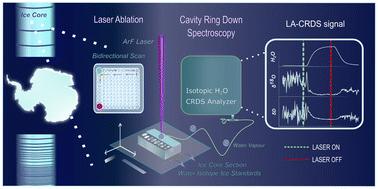Our official English website, www.x-mol.net, welcomes your
feedback! (Note: you will need to create a separate account there.)
Towards high-resolution water isotope analysis in ice cores using laser ablation – cavity ring-down spectroscopy
Analyst ( IF 3.6 ) Pub Date : 2024-11-12 , DOI: 10.1039/d4an01054j Eirini Malegiannaki, Pascal Bohleber, Daniele Zannoni, Ciprian Stremtan, Agnese Petteni, Barbara Stenni, Carlo Barbante, Bo M. Vinther, Vasileios Gkinis
Analyst ( IF 3.6 ) Pub Date : 2024-11-12 , DOI: 10.1039/d4an01054j Eirini Malegiannaki, Pascal Bohleber, Daniele Zannoni, Ciprian Stremtan, Agnese Petteni, Barbara Stenni, Carlo Barbante, Bo M. Vinther, Vasileios Gkinis

|
A new micro-destructive technique for high-resolution water isotope analysis of ice samples using a Laser Ablation (LA) system coupled with a Cavity Ring Down Spectrometer (CRDS) is presented. This method marks the first time water isotope analysis is conducted directly on the ice, bypassing the traditional steps of melting and vaporizing the ice sample, thanks to the direct transition of ice into water vapour through the laser ablation process. A nanosecond ArF laser ablation system (193 nm) with an integrated two-volume ablation chamber was successfully coupled to a CRDS analyzer, utilizing nitrogen as the carrier gas. The application goal is the use of LA-CRDS for ice core studies, so a method for preparing ice standard samples using liquid water isotope standards, widely used for ice core analysis, is introduced. The measurements were conducted in a discrete mode, by performing laser ablation raster scans of 4 mm × 4 mm areas, establishing a sampling resolution of 4 mm along an ice core's depth. The water vapour concentration reaching the CRDS analyzer as well as the quality of the water isotopic measurements of δ18O and δD were influenced by laser parameters, such as laser spot size, repetition rate, laser fluence, ablation time as well as by the flow rates of the carrier gas. After optimizing the experimental conditions for water vapour formation, three ice standards samples were analyzed for calibration purposes on the VSMOW-SLAP scale and a section of an ice core sample was also tested. Critical parameters influencing the precision and accuracy of water isotopic measurements were investigated, and isotopic fractionation phenomena were identified, pointing to essential considerations for the technique's further development.
中文翻译:

使用激光烧蚀 – 光腔衰荡光谱法实现冰芯中的高分辨率水同位素分析
提出了一种使用激光消融 (LA) 系统耦合光腔衰荡光谱仪 (CRDS) 对冰样品进行高分辨率水同位素分析的新型微破坏技术。该方法标志着水同位素分析首次直接在冰上进行,由于通过激光烧蚀过程将冰直接转化为水蒸气,绕过了传统的冰样品熔化和蒸发步骤。利用氮气作为载气,将带有集成双体积烧蚀室的纳秒 ArF 激光烧蚀系统 (193 nm) 成功耦合到 CRDS 分析仪。应用目标是使用 LA-CRDS 进行冰芯研究,因此引入了一种使用液态水同位素标准品制备冰标准品的方法,该方法广泛用于冰芯分析。测量以离散模式进行,通过对 4 mm × 4 mm 区域进行激光烧蚀光栅扫描,沿冰芯深度建立 4 mm 的采样分辨率。达到 CRDS 分析仪的水蒸气浓度以及 δ18O 和 δD 的水同位素测量质量受激光参数的影响,例如激光光斑尺寸、重复率、激光通量、烧蚀时间以及载气的流速。在优化了水蒸气形成的实验条件后,在 VSMOW-SLAP 量表上分析了三个冰标准样品以进行校准,并且还测试了冰芯样品的一部分。 研究了影响水同位素测量精度和准确性的关键参数,并确定了同位素分馏现象,为该技术的进一步发展指明了重要的考虑因素。
更新日期:2024-11-12
中文翻译:

使用激光烧蚀 – 光腔衰荡光谱法实现冰芯中的高分辨率水同位素分析
提出了一种使用激光消融 (LA) 系统耦合光腔衰荡光谱仪 (CRDS) 对冰样品进行高分辨率水同位素分析的新型微破坏技术。该方法标志着水同位素分析首次直接在冰上进行,由于通过激光烧蚀过程将冰直接转化为水蒸气,绕过了传统的冰样品熔化和蒸发步骤。利用氮气作为载气,将带有集成双体积烧蚀室的纳秒 ArF 激光烧蚀系统 (193 nm) 成功耦合到 CRDS 分析仪。应用目标是使用 LA-CRDS 进行冰芯研究,因此引入了一种使用液态水同位素标准品制备冰标准品的方法,该方法广泛用于冰芯分析。测量以离散模式进行,通过对 4 mm × 4 mm 区域进行激光烧蚀光栅扫描,沿冰芯深度建立 4 mm 的采样分辨率。达到 CRDS 分析仪的水蒸气浓度以及 δ18O 和 δD 的水同位素测量质量受激光参数的影响,例如激光光斑尺寸、重复率、激光通量、烧蚀时间以及载气的流速。在优化了水蒸气形成的实验条件后,在 VSMOW-SLAP 量表上分析了三个冰标准样品以进行校准,并且还测试了冰芯样品的一部分。 研究了影响水同位素测量精度和准确性的关键参数,并确定了同位素分馏现象,为该技术的进一步发展指明了重要的考虑因素。































 京公网安备 11010802027423号
京公网安备 11010802027423号